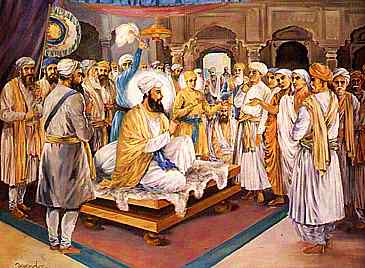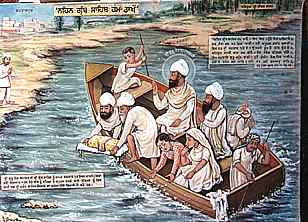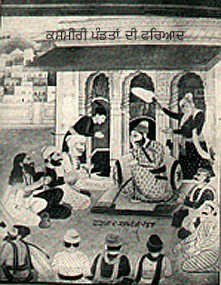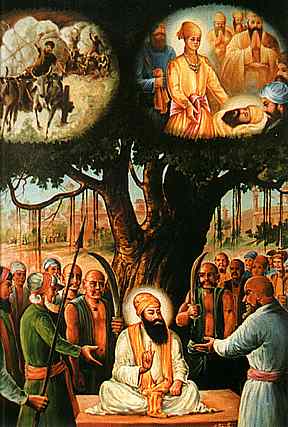Sri Guru Tegh Bhadur Sahib Ji
AURANGZEB'S CAMPAIGN OF RELIGIOUS PERSECUTION:
As Aurangzeb ascended the throne of India by imprisoning his father and murdering his brothers, he decided to enlist the sympathies of the fanatical section of his co-religionists. His idea was to exterminate the idolatrous Hindus and to convert the whole of India to Islam. In order to achieve this objective he tried to go through four fundamental means to deal with the Hindus. Firstly he made peaceful overtures; secondly he offered money; thirdly he threatened punishment and lastly he tried to cause dissention among them. When all these measures failed, he resorted to forcible conversion. Orders were issued to the governors of all the provinces that they should destroy the schools and temples of the infidels and thereby put an end to educational activities as well as the practices of the religion of the Kafirs (non-Muslims meant Hindus). Many temples at Mathura and Banaras were destroyed. Even a Sikh temple in Buriya in Khizrabad pargna of Sirhind had been demolished and a mosque was built on the site. Some Sikhs, however, attacked the mosque and killed the priest. This type of incidents had become common occurrences. In order to force conversion to Islam, all possible means were adopted. In the field of taxation, the policy of discrimination was launched with great vigor. Jaziya and pilgrimage taxes were re- evied. Five percent custom duty was levied on the Hindus while the Muslims were charged only half of that.
The proselytizing zeal of the officials, with their campaign of religious persecution and their conversion at the point of the sword, had sent the wave of terror throughout the country. Sher Afghan Khan, the Emperor's viceroy in Kashmir, set about converting the Kashmiri Hindus by force and massacred those who opposed to embrace Islam. Even the Mohammadans who in any way assisted the Hindus, were mercilessly put to death. In extreme agony of too much slaughter, the Brahman priests of Kashmir prayed to their gods. It is said that the Kashmiri Brahmans heard a supernatural voice who told them," Guru Nanak is the spiritual king in this age. Guru Tegh Bahadur is now seated on his throne. Go to him, he will protect your honor and your religion."
KASHMIRI BRAHMANS COME TO GURU:
 |
| A delegate of 500 Kashmiri Brahmins led by Pandit Kirpa Ram met Guru Teg Bahadur Ji at Anandpur Sahib. Pandit Kirpa Ram told the harrowing tales of torture initiated by the orders of Aurangzeb (r. 1658-1707 AD) for converting them to Islam. Guru Ji was mentally occupied with the issue when the child Gobind Rai happened to be there and asked as to what was the matter. Guru Ji told him that the sacrifice of a Great Soul is called for. "Who else than You can serve this cause?" - was the child Gobind Rai's spontaneous reaction. |
A deputation of Kashmiri Pandits (Brahmans) came to Anandpur and among tears of agony, they narrated their tales of woe and suffering to the Master. The Guru's eight years old son appeared on the scene and asked his father why those people had tears in their eyes. He replied," The Emperor of India is converting the Hindus to Islam at the point of the sword and thus there is no end to the misery of these people."
"What is the remedy, father?" asked the son.
The Guru replied," This requires sacrifice- sacrifi ce of a holy and supreme soul." His son responded," O dear father, who is more holy than you in this age? Go and offer yourself and save these people and their religion." On hearing this the Guru asked the Kashmiri Brahmans to go to the Emperor and make the following representation to him," Guru Tegh Bahadur, the ninth Sikh Guru is now seated on the throne of the great Guru Nanak, who is the protector of faith and religion. First make him a Musalman and then all the people, including ourselves, will of our own accord adopt the faith of Islam."
The Pandits obeyed the Guru and conveyed the proposal to the Emperor. On hearing this proposal, the Emperor was very much pleased because he thought that it was much easier to convert one person than the whole lot. He retorted," If the Guru does not become Musalman, he will then at least show us a miracle." He was hopeful that once the Guru was converted, there would be a large accession of Hindu and Sikh converts. The Emperor, therefore, sent his emissary to the Guru to invite him to Delhi. The Guru received Emperor's message and wrote in reply that he would come to Delhi after the rainy season.
MARTYRDOM OF GURU TEGH BAHADUR:
The Guru took leave of his family and his devoted Sikhs and began his journey to Delhi sometimes in June-July. rom Anandpur he passed through Kiratpur, Rupar and various villages before reaching Saifabad in Patiala state to see his Muslim friend Saif-ul-din. He stayed for sometimes with him. Saif-ul-din became his disciple. He went to Samana where he met another disciple called Mohammad Bakhsh. The Guru continued his journey through Kaithal, Lakhan Majra, Rohtak and other places, conferring temporal and spiritual favors on his disciples, and finally he reached Agra where he encamped in a garden outside the city.
After the rainy season, the Emperor again sent his messenger to hasten the Guru's presence to Delhi. When the messengers were unable to find the Guru, they reported that he had fled. Orders were issued all over the empire to find and arrest him. There are different views about the place of Guru's arrest. Some writers say that he was arrested at Dhamdhan; some say that he was arrested at Malikpur near Rupar and others say that the arrest was effected at Delhi while others still account for his arrest at Agra. According to Sikh accounts there lived a poor old man, Hasan Ali, at Agra. He knew that there were orders about Guru's arrest and the person who could effect his arrest, would receive one thousand rupees as a reward. Hasan Ali prayed," O true Guru, if ever you want to get arrested, please do it through me. This will fetch me some money to bring my family out of the clutches of miserable poverty." The Guru being the searcher of hearts, came to Agra to get arrested through Hasan Ali.
 |
| The Sikhs had robbed the Kartarpur Sodhis of the Adi Granth when Guru Ji was declared the Real Guru. When Guru Ji came to know of this he told the Sikhs to return the Adi Granth. But as the Sikhs were far from the town, the Adi Granth was kept for safe keeping in the river and a message was sent to the Sodhis to recover the Adi Granth from the river bed. The Sodhis could not locate it as they were not mentioning the name of the 9th Guru. When Guru Teg Bahadur Ji's name was mentioned in the Ardaas, the Adi Granth was located, without any harm done to it by the water. |
The Guru saw a shepherd boy in the garden whom he gave his gold ring studded with diamonds and asked him to pledge it and bring him two rupees worth of sweets. When the boy told him that he had no cloth to wrap the sweets, the Guru gave him his valuable shawl for that purpose. The boy took his grandfather, Hasan Ali along with him and stopped at the confectioner's shop, gave him the ring and asked for sweets to be wrapped in the shawl. On seeing the ring and the valuable shawl, the confectioner was astonished and asked the boy from whom he had received those articles. The boy told him the truth but the confectionerbecame suspicious and took them to the police. The police went to the garden with the boy and asked the Guru who he was. When he disclosed his identity, the police officer was delighted that he would get a large reward from the Emperor for his capture. The Guru was thus imprisoned. The Governor of the fort reported the arrest to the Emperor. Ultimately he was brought to Delhi. There were three Sikhs, Bhai Mati Das, Bhai Dayala and Bhai Sati Das with the Guru (Some writers account for five Sikhs- Mati Das, Gurditta, Uda, Chima and Dayala) who were arrested with him and were brought to Delhi.
The Emperor explained that God appeared to him in a vision and told him to convert the whole world to Islam. Those who were to embrace Islam, would be rewarded with wealth, appointments, land revenue grants and lands. The Emperor tried to lure him," In this way you will have many disciples, and you will become a great priest of Islam. Therefore accept my religion- Islam, and you will receive from me whatever your heart desire." The Guru asked for one and one-quarter of maan (about 100 pounds) of black pepper. When it was brought, it was put into a heap and was ignited. The heap of pepper was let burning for twenty-four hours and was apparently reduced to ashes. The heap was then pounded and sifted. Three pepper pods came out as whole. The Guru addressed," O Emperor, you desire that there should be only one religion (Islam) out of two religions (Hinduism and Islam), but as these three pepper pods have been saved from the fire, God wishes to make three religions out of two. So there shall be three religions- Hinduism, Islam, and Sikhism in the future."
Upon this it was ordered that the Guru be imprisoned with sufficient guards around him. Again he was sent or and was told that if he embraced Islam, every service would be performed for him otherwise he would be severely tortured. He replied that he would never embrace Islam and thus, remained in Delhi jail for eight days. He was given three choices: firstly to embrace Islam; secondly to perform a miracle; and thirdly to prepare himself to court death. The Guru responded that to show a miracle was against the Will of God and thus he would not consent to the Emperor's proposals and the Emperor might act as he pleased. He was then put to extreme tortures.
 It is said
that
there was conversation between the Guru and his disciple Bhai Mati Das. He told Mati Das that Guru Nanak had
blessed
Emperor Babar with the continuation of his empire for a long time. Since the Mughal Emperors started
committing
great enormities, their line would be exterminated if he (Guru) laid down his life. In consequence of this
conversation which was overheard by a priest, Bhai Mati Das was bound between two pillars and his body was
sawn
asunder. When the executioners put saw on his head, he began to recite Japji (the first Bani in Guru Granth
Sahib).
It is said that when his body was cut into two, he continued reciting Japji and he was silent only when the
recitation of Japji was complete. This was a wonder of Guru's Grace. Bhai Dayala was boiled to death in a
cauldron
of hot water. It is said that the third companion Bhai Sati Das was roasted alive with cotton wrapped round
his
body. The authorities thought that these tortures of his Sikhs might shake the Guru. Nothing could and
nothing can
shake the Divine Light (the Guru).
It is said
that
there was conversation between the Guru and his disciple Bhai Mati Das. He told Mati Das that Guru Nanak had
blessed
Emperor Babar with the continuation of his empire for a long time. Since the Mughal Emperors started
committing
great enormities, their line would be exterminated if he (Guru) laid down his life. In consequence of this
conversation which was overheard by a priest, Bhai Mati Das was bound between two pillars and his body was
sawn
asunder. When the executioners put saw on his head, he began to recite Japji (the first Bani in Guru Granth
Sahib).
It is said that when his body was cut into two, he continued reciting Japji and he was silent only when the
recitation of Japji was complete. This was a wonder of Guru's Grace. Bhai Dayala was boiled to death in a
cauldron
of hot water. It is said that the third companion Bhai Sati Das was roasted alive with cotton wrapped round
his
body. The authorities thought that these tortures of his Sikhs might shake the Guru. Nothing could and
nothing can
shake the Divine Light (the Guru).
It is generally believed in Sikh circles that there was some communication between the Guru and his son when the Guru was being detained in Delhi jail before his execution. The story runs that Guru Tegh Bahadur foreseeing his execution, wanted to test the capability of his nine years old son and so he wrote the following couplet (Slok) and sent it through a messenger to Anandpur:
"All power shattered, humanity in fetters and availeth no resource;
Saith Nanak, God is now only refuge; He should succor as He did the elephant."
(Slok Mohalla 9 (53), p-1429)
It is being assumed that the Guru's nine years old son wrote back:
"With power, fetters break, availeth all in grace Divine;
Nanak, everything is in Thy power, it is only Thou Who canst assist."
(Slok Mohalla 9 (54), p-1429)
It is the common opinion that upon receiving this reply, the Guru was convinced that his son was capable to take reigns of the Guruship.
Let us examine the merits of the above story which is prevalent in Sikh circles:
Firstly there are 57 Sloks (couplets) at pages 1426-29 of Guru Granth Sahib which begin under the heading
'Slok Mohalla 9'. This heading means that all the Sloks under this heading were uttered by the
Ninth Guru.
Secondly how far it is valid to say that the Guru wanted to test the capability of his son? Being a
Divine Guru and sitting on the throne of Guru Nanak, did he not know himself whether the son was
capable? Did he have to ask him?
Thirdly if it is argued that the Guru was worried about the young age of his son to take command of
Guruship, what about the eighth Guru? The eighth Guru was only five years old when he was installed
on the throne of Guru Nanak. How much this argument of being too young holds good?
Fourthly as explained earlier also, in the case of Guruship, the age, experience and intelligence of a
person did not matter. Once the person was invested with the Guruship, then the Divine Power
worked itself, and the age, experience and intelligence of a person in question was of no consequence.
In the light of the above circumstances, it seems evident that all the 57 Sloks belong to the Ninth Guru
and none to the Tenth Guru.
The final message was given to the Guru," You are to accept the religion of Islam or show a miracle. If you work a miracle, you may remain a Guru. If you accept Islam, then you will be advanced to an exalted position. If you fail to accept these offers, you shall be put to death. This is the final decision."
The Guru emphasized," I will never abandon my faith. I want no honor in this life; I want honor hereafter. The threat of death possesses no terrors for me. For death I am prepared and I cheerfully accept it."
 |
| Guru Teg Bahadur Ji reached Delhi for a trial between his serenity and Aurangzeb's tyranny. Aurangzeb sent a message that he will pardon him if Guru Ji would convert to Islam. Guru Ji's reply was that his religion was to defend mankind and that cannot be changed. Many a threat was conveyed to him through the Mullahs but he remained resolute. Guru Ji, who was confined in a cage, was brought in front of milling crowds, released and beheaded by an executioner called Sayyiad Jalal Din of Samana village, with a sword. This happened on the 11the of November 1675. Now Gurdwara Sis Ganj is located at the spot. Bhai Jaita brought the Guru's head to Anandpur Sahib to Guru Gobind Rai abd lakhi Shah cremated the body by setting fire to his house. Gurdwara Rakab Ganj stands at the cremation spot. |
Hearing this reply it was ordered that the Guru should be executed. Saiyid Adam Shah accompanied by courtiers and Muslim priests came with a warrant for his execution. Many people turned out to witness the execution. He was then taken out of his cage and allowed to perform his ablutions. He sat under the banyan-tree where he recited Japji. The executioner, Jalal-ud-din of Samana (some say it was Adam Shah) took his sword and in a split of second, severed Guru's head from the body. This happened on the afternoon of Thursday, the fifth day of the light half of the month of Maghar in Sambat 1732 (November 11, 1675) at Chandni Chowk, Delhi where now stands Gurdwara Sis Ganj in his memory. This Gurdwara was constructed by Sardar Baghel Singh Karor-Singheiye in 1790.
History has recorded that a furious storm raged immediately after this brutal deed which filled every one's eyes with dust. Bhai Jaita dashed out of the crowd and instantaneously took away the holy head of the Guru to Anandpur. He reached Kiratpur on the 15th of November, 1675. From there the Guru's head was taken to Anandpur with full honor and on the 16th of November, 1675, it was cremated with full ceremonies. There is a Gurdwara called Sis Ganj at Anandpur where the hallowed head of the Guru was cremated. The tenth Guru received Bhai Jaita who belonged to backward classes, embraced him and said," Rangrettei Guruke bettei" (Rangrettei were the sons of the Guru, Rangrettei was Bhai Jaita's caste). Bhai Jaita told the young Guru and his family how Guru Tegh Bahadur had sent for five paise and a coco- nut and bowed to his son Gobind Rai, made him the successor and infused his Light unto him.
Lakhi Shah Labana was a famous contractor in Delhi and he was also a follower of the Guru. He emptied his carts laden with lime near the Red Fort, taking advantage of the darkness and the carelessness of the Mughal sentries, and with the help of his sons, Nagahiya, Hema, Harhi and his friend Dhuma, whisked away the sacred body of the Guru, in one of their carts. Apprehensive of the government reprisal, Lakhi Shah and his sons then built up a pyre inside their own house and set fire to it. When the body was duly reduced to ashes, they cried out that their house had caught fire and called upon their neighbors to assist them in extinguishing it. Next day they collected the Guru's remains and buried them in a copper vessel called 'gaggar' in the earth under his funeral pyre. On this spot there stands a Gurdwara, Rakab Ganj, near Parliament House in New Delhi.
"Having broken his potsherd on the head of the king of Delhi, he departed for Paradise;
No one else coming into the world acted like Tegh Bahadur. The world was in mourning for the
departure of Tegh Bahadur;
There was weeping for him in the whole world, but rejoicing in paradise."
(Guru Gobind Singh- Bachitar Natak)
FN-1:Guru belonged to Sodhi clan.
FN-2:It is said that Aurangzeb was at Hasan Abdal at that time but he was being continually reported about the Guru's activities.
FN-3:Some writers say that Emperor Aurangzeb was not at Delhi at that time as he had gone on an expedition to Hasan Abdal, but Guru's execution was carried on as per orders of him. Others say that all conversation took place directly between the Guru and Aurangzeb because this opportunity was unique and of utmost importance to achieve his goal of ultimate mass conversion toIslam.
FN-4:It is said that the Guru had told Bhai Jaita that his head would fall into his lap, and he should fear nobody, take it to Anandpur and cremate it there. It is also said that Bhai Jaita shared this secret with his neighbor Bhai Nanu and he also took Bhai Uda, a resident of Ladwa, into confidence and three of them took Guru's head to Anandpur.

